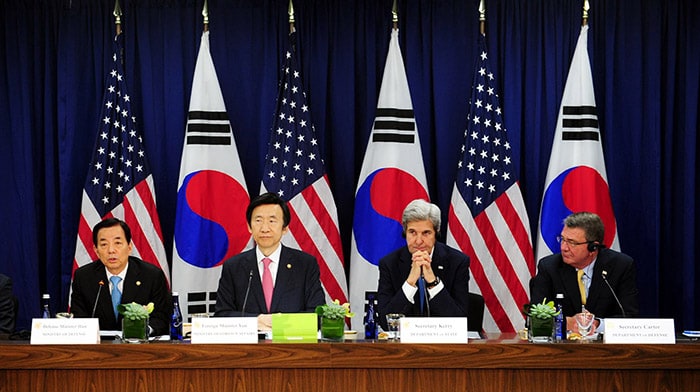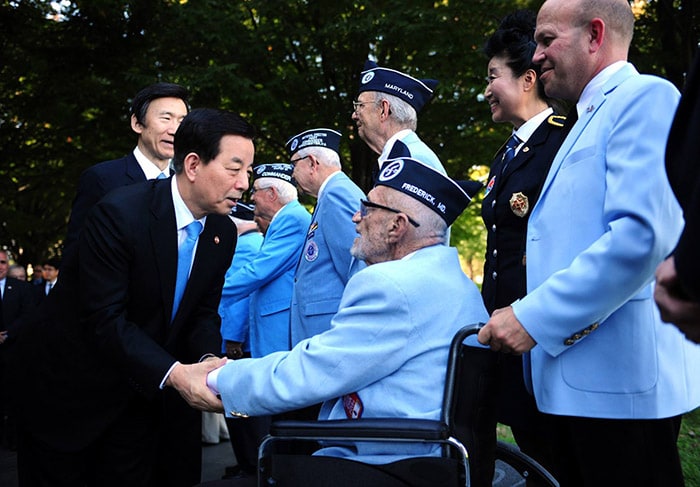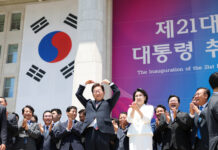
On Oct. 19, Minister of National Defense Han Minkoo (left) and Minister of Foreign Affairs Yun Byung-se (second from left) engage in a ‘two plus two’ dialogue with their U.S. counterparts, Secretary of State John Kerry (third from left) and Defense Secretary Ash Carter, in Washington, D.C. During the talks, the U.S. agreed to expand its deterrence doctrine against North Korea in order to protect Korea and its Asian allies from nuclear weapon and missile threats.
Korea and the U.S. have agreed to establish an Extended Deterrence Strategy and Consultation Group (EDSCG) to better ensure the protection of Korea and the U.S.’ allies from North Korean nuclear weapon and missile threats.
On Oct. 19, Minister of Foreign Affairs Yun Byung-se and Minister of National Defense Han Minkoo engaged in a “two plus two” dialogue in Washington, D.C., with their U.S. counterparts, Secretary of State John Kerry and Defense Secretary Ash Carter. Afterward, they released a joint statement covering the expansion of the U.S.’ deterrence doctrine.
The EDSCG will establish a dialogue between Korea and the U.S. concerning “extended deterrence,” which refers to a commitment to use nuclear weapons to deter attacks from North Korea.
According to the Ministry of Foreign Affairs, the vice minister-level dialogue will bring together the Korean ministries of foreign affairs and defense and the U.S.’ departments of state and defense, and create a forum where comprehensive, multidimensional negotiations can take place, operating in a similar manner to the North Atlantic Treaty Organization (NATO).
“Any attack on the U.S. or its allies will be defeated, and any use of nuclear weapons will be met with an effective and overwhelming response,” said Secretary Kerry during a joint news conference with Minister Yun after the talks. “The U.S. is committed to defending South Korea through a robust defense posture and through extended deterrence, including the U.S. nuclear umbrella, conventional strikes and missile defense capabilities,” he said.

Minister of Foreign Affairs Yun Byung-se (left) and Minister of National Defense Han Minkoo (second from left) meet with U.S. veterans of the Korean War at the Korean War Veterans Memorial in Washington, D.C., on Oct. 18.
Furthermore, Korea and the U.S. agreed that North Korea will pay an unbearable cost should it not abandon its nuclear weapons. To this end, the two nations agreed to work together to apply greater pressure and stiffer sanctions on the North Korean regime.
Minister Yun said that his U.S. counterparts reaffirmed that the U.S. would “defend South Korea from any and all North Korean threats through extended deterrence, encompassing all parameters of defense capabilities.” Secretary Kerry said, “On deterrence, we’ve made it clear that we would deploy THAAD as rapidly as possible to make sure that our allies are protected against any threats.”
The leaders also recognized the need to accelerate change in North Korea, and agreed to address a range of North Korean issues, including human rights abuses, overseas slave labor, and facilitating the flow of information into the North. They also said they will be working with the EU on the ongoing North Korean human rights resolution at the U.N. General Assembly.
Finally, as to the question of diplomacy and regional issues, the two countries stressed the importance of cooperating with China in a constructive manner. Mentioning the cooperation that exists between Korea, Japan and China, the leaders discussed expanding the Northeast Asia Peace and Cooperation Initiative (NAPCI).
By Lee Hana
Korea.net Staff Writer
Photos: Ministry of National Defense
hlee10@korea.kr























